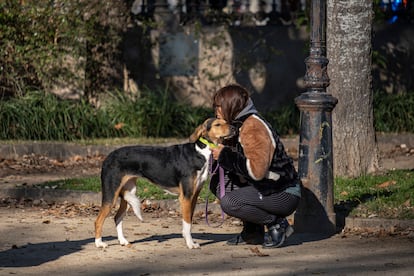Science explores the origins of the friendship between dogs and humans
Recent studies confirm dogs’ ability to understand us, their natural talent for empathizing with other species and the pleasure we get from sharing our lives with them

It is often said that dogs are man’s best friend, but less often that they are the oldest. Dogs were the first domesticated animal in history. The two species stitched their evolutionary destinies together some 15,000 years ago, establishing a symbiotic relationship with few analogues in the animal world. It’s a rarity. Decades ago, archaeologists and zoologists posited that this relationship was born of utility but that, over the years, a fondness and understanding emerged between the two species that science is now trying to measure. In recent years, several studies have analyzed how this joint evolution has affected dogs and humans. In the past 20 years, the scientific literature on this subject has proliferated. And so has the conventional one. It is estimated that there are over 70,000 books about dogs on Amazon: a further sign that this prehistoric friendship is coming to the present in top form.
Onyoo Yoo has a beautiful four-year-old poodle named Aroma; they call her Aro at home. There were others before: Yoo has spent her whole life surrounded by dogs and knows from personal experience that these animals can bring joy and comfort, although she doesn’t quite understand the mechanisms that make this possible. Last year, Yoo took her dog to work to find out. She asked 30 volunteers to pet Aro, give her treats, walk her and play with her. Meanwhile, Yoo, who is a researcher at Konkuk University in South Korea, analyzed their brain activity.
“Our research found that participants’ alpha band brain waves [related to relaxation] increased while playing and walking with my dog. While beta band brain waves [associated with concentration] did so while grooming, massaging or playing with her,” Yoo explains. Recently published in the scientific journal PLOS One, the study confirms something many people feel: spending time with dogs is enormously pleasurable. But it does so in detail, “providing valuable information to elucidate the therapeutic effects and underlying mechanisms of animal-assisted interventions,” Yoo explains.
Pet ownership is known to help reduce stress levels, promote positive emotions and reduce the risk of cardiovascular disease. “However, research on the brain activity produced by human-animal interaction is incipient and insufficient,” says Yoo. This may be because, in order to understand it, one needs not only neurology and psychology but also paleobiology, in addition to taking a look back.
Initiating a friendship is not always easy, and the one forged between people and dogs did not start by petting a wolf or throwing a ball at it. Domestication was multifactorial and happened in fits and starts. An ambitious study published in Science in 2020 attempted to trace that process by sequencing 27 ancient dog genomes. In analyzing them, the authors discovered that dogs probably arose from a now-extinct population of wolves. They also distinguished at least five different dog populations, drawing a complex ancestral history. Different types of dogs expanded with the other human groups, linking their destinies (and eventual disappearance) to the survival of the clan with which they were associated.
Aritza Villaluenga, a researcher at the University of the Basque Country UPV/EHU (Spain) and a co-author of the study, points out that the first (albeit disputed) evidence of coexistence between humans and wolves dates back to 25,000 years ago: “It was probably not a conscious domestication, they did not know what they were doing, they did not conceive of what the result was going to be. They simply had animals to help them hunt.” We have to jump forward 10,000 years to when dogs first appeared in a sustained way. “And here, yes, we can talk about dogs because genetically they’re different from the wolves living in the same area at the same time. There [were] physical and genetic changes,” Villaluenga explains.
Hunting allies
At that time, their coexistence was symbiotic. “The partnership suited [both] dogs and humans. The dogs pushed herds of animals to where the human hunters were hiding,” the expert notes. The former were much better at running and the latter at strategizing. They formed a good team when hunting and, once the game was caught, they both shared the spoils. Thus, from the beginning of the relationship, it was very important for both species to understand each other, to be able to read each other.
Researchers at Stockholm University (Sweden) conducted an experiment with wolf cubs and found that some specimens can understand human cues and comprehend their playful intentionality. They proved this with something as trivial as throwing them a ball and asking them to bring it back. In everyday life, this action seems simple because many people do it with their pets daily. But that task involves great cognitive complexity, and in a few seconds, it demonstrates the ability of two species to understand each other that has been forged over millennia. The study suggested that this ability, present in some very sociable specimens, may have led to their domestication. Associating with humans was an evolutionary success in all respects. Today, it is estimated that for every wolf, there are 3,000 dogs.
Some 5,000 generations after that prehistoric union, today’s dogs can understand many more human commands, gestures and words. Mariana Boros, a neuroethologist at Loránd University in Budapest (Hungary), knows that well. She just published a study that analyzes how dogs can understand words. “The most important ability this animal has is the ability to understand human communication. They are exceptional,” the expert observes in a video call.
Boros and her team wanted to test whether this understanding was due to vocalization rather than context. So, they locked a dog in a room, announced that they were going to give him one object, say a ball, and then offered him another, for example, a stick. “We thought that if the dog understood what the word meant, it would have an expectation of what it would see next. And the violation of that expectation would be visible on the EEG,” Boros explains. And, indeed, it was. With this data, the team can be sure that dogs understand the word’s meaning. “In fact, the understanding mechanisms are very similar to what we see in humans,” Boros adds.

Love beyond understanding
Most scientific literature concludes that dogs have a special bond with humans for this reason. They understand us and communicate with us better than any other animal. But psychologist Clive Wynne of the University of Arizona disagrees. In his book Dog is Love, he argues that dogs have a unique capacity for interspecies love. If you raise a dog with sheep, goats or cats (or even tigers or lions), it will end up joining them and getting attached to them, he explains, using examples. Something similar would have happened with humans. Wyne’s hypothesis is backed up by science. In 2015, Japanese scientists showed that the more people looked into their dogs’ eyes, the more they both increased their production of oxytocin, the key chemical ingredient of affection. It’s not that they understand the humans with whom they live; it is that they love them.
In any case, understanding is not the only aspect in which dogs have evolved to adapt to our tastes. According to several studies, they have also become more adorable and expressive. Charles Darwin was the first to realize that domestic animals — such as cats, dogs and rabbits — share certain physical traits. They tend to have droopier ears and curlier tails than their wild ancestors. Their teeth are smaller, and they have white patches on their fur. This phenomenon is known as domestication syndrome.
The most eloquent example of this process occurred at a Soviet fox farm in the 1950s. Geneticist Dmitri K. Belyaev wanted to create a domestic fox population by selecting and crossing the tamest specimens. The results were analyzed in a scientific study in 2009. By the fourth generation, the foxes were licking scientists and greeting them with tail wags. Their offspring were even more domesticated and could understand human signals and respond to gestures or looks. “They not only developed internal traits such as acceptance of human closeness. Physically, they became more pup-like, cuter. They changed to be more adorable to the human eye and presumably that same thing happened to dogs,” Boros explains.
The difference is that, with the foxes, this happened artificially and forcibly in just 50 years, while the domestication of the wolf into a dog was natural and presumably took much longer. This process was not born of man’s whim, as Villaluenga explained. Some Stone Age wolves showed a natural inclination to befriend the strange apes that spread throughout the world. They understood each other not only when hunting, but also when playing and being affectionate with each other. When they looked at each other, they both felt strangely good. These wolves got closer and closer to the humans and mingled with other wolves that were also hanging around human settlements. They decided to stay close, and it turned out to be for the best. According to this interpretation, shared by many specialists, the dog was not domesticated, but rather some wolves became self-domesticated and ended up becoming dogs. They chose us, at least as much as we chose them.
Sign up for our weekly newsletter to get more English-language news coverage from EL PAÍS USA Edition
Tu suscripción se está usando en otro dispositivo
¿Quieres añadir otro usuario a tu suscripción?
Si continúas leyendo en este dispositivo, no se podrá leer en el otro.
FlechaTu suscripción se está usando en otro dispositivo y solo puedes acceder a EL PAÍS desde un dispositivo a la vez.
Si quieres compartir tu cuenta, cambia tu suscripción a la modalidad Premium, así podrás añadir otro usuario. Cada uno accederá con su propia cuenta de email, lo que os permitirá personalizar vuestra experiencia en EL PAÍS.
¿Tienes una suscripción de empresa? Accede aquí para contratar más cuentas.
En el caso de no saber quién está usando tu cuenta, te recomendamos cambiar tu contraseña aquí.
Si decides continuar compartiendo tu cuenta, este mensaje se mostrará en tu dispositivo y en el de la otra persona que está usando tu cuenta de forma indefinida, afectando a tu experiencia de lectura. Puedes consultar aquí los términos y condiciones de la suscripción digital.
More information
Últimas noticias
Most viewed
- Reinhard Genzel, Nobel laureate in physics: ‘One-minute videos will never give you the truth’
- Oona Chaplin: ‘I told James Cameron that I was living in a treehouse and starting a permaculture project with a friend’
- Pablo Escobar’s hippos: A serious environmental problem, 40 years on
- Charles Dubouloz, mountaineering star, retires at 36 with a farewell tour inspired by Walter Bonatti
- Why we lost the habit of sleeping in two segments and how that changed our sense of time











































